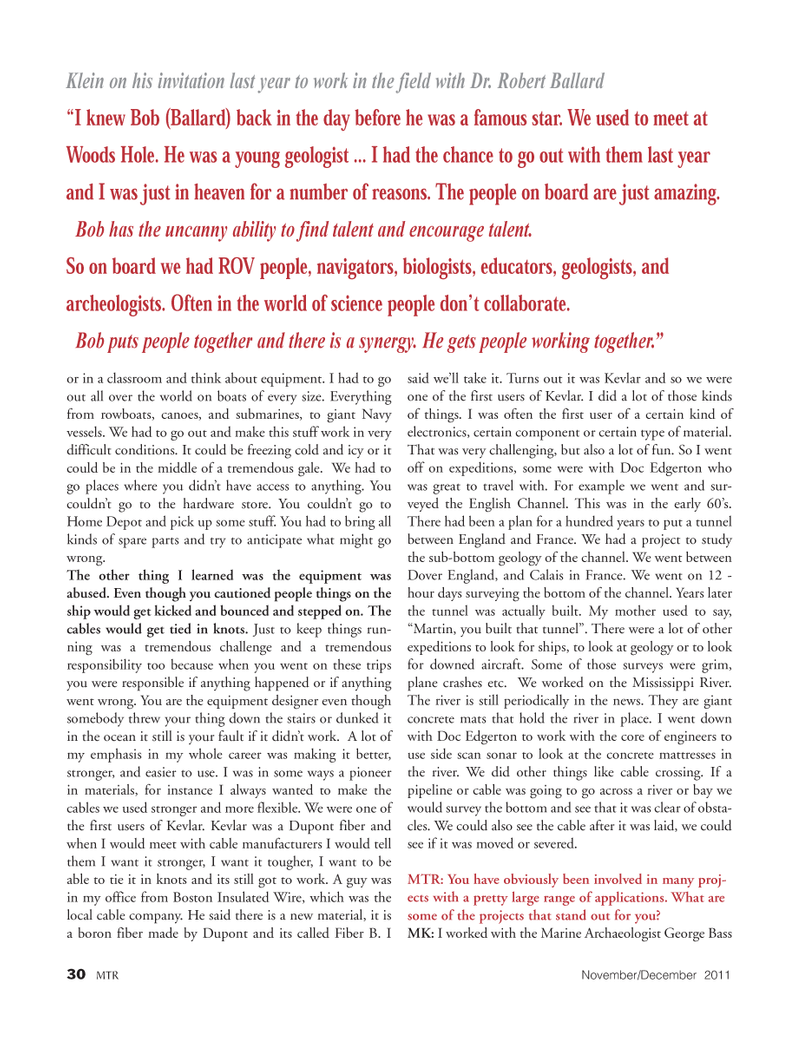
Page 30: of Marine Technology Magazine (November 2011)
FreshWater Monitoring and Sensors
Read this page in Pdf, Flash or Html5 edition of November 2011 Marine Technology Magazine
30MTRNovember/December 2011or in a classroom and think about equipment. I had to go out all over the world on boats of every size. Everything from rowboats, canoes, and submarines, to giant Navy vessels. We had to go out and make this stuff work in very difficult conditions. It could be freezing cold and icy or it could be in the middle of a tremendous gale. We had to go places where you didn?t have access to anything. You couldn?t go to the hardware store. You couldn?t go to Home Depot and pick up some stuff. You had to bring all kinds of spare parts and try to anticipate what might go wrong. The other thing I learned was the equipment wasabused. Even though you cautioned people things on the ship would get kicked and bounced and stepped on. The cables would get tied in knots.Just to keep things run- ning was a tremendous challenge and a tremendous responsibility too because when you went on these trips you were responsible if anything happened or if anything went wrong. You are the equipment designer even though somebody threw your thing down the stairs or dunked it in the ocean it still is your fault if it didn?t work. A lot of my emphasis in my whole career was making it better, stronger, and easier to use. I was in some ways a pioneer in materials, for instance I always wanted to make thecables we used stronger and more flexible. We were one of the first users of Kevlar. Kevlar was a Dupont fiber and when I would meet with cable manufacturers I would tell them I want it stronger, I want it tougher, I want to be able to tie it in knots and its still got to work. A guy was in my office from Boston Insulated Wire, which was the local cable company. He said there is a new material, it is a boron fiber made by Dupont and its called Fiber B. I said we?ll take it. Turns out it was Kevlar and so we were one of the first users of Kevlar. I did a lot of those kinds of things. I was often the first user of a certain kind of electronics, certain component or certain type of material. That was very challenging, but also a lot of fun. So I went off on expeditions, some were with Doc Edgerton who was great to travel with. For example we went and sur- veyed the English Channel. This was in the early 60?s. There had been a plan for a hundred years to put a tunnel between England and France. We had a project to study the sub-bottom geology of the channel. We went between Dover England, and Calais in France. We went on 12 - hour days surveying the bottom of the channel. Years later the tunnel was actually built. My mother used to say, ?Martin, you built that tunnel?. There were a lot of other expeditions to look for ships, to look at geology or to lookfor downed aircraft. Some of those surveys were grim, plane crashes etc. We worked on the Mississippi River. The river is still periodically in the news. They are giant concrete mats that hold the river in place. I went down with Doc Edgerton to work with the core of engineers to use side scan sonar to look at the concrete mattresses in the river. We did other things like cable crossing. If a pipeline or cable was going to go across a river or bay we would survey the bottom and see that it was clear of obsta- cles. We could also see the cable after it was laid, we could see if it was moved or severed. MTR: You have obviously been involved in many proj- ects with a pretty large range of applications. What are some of the projects that stand out for you? MK: I worked with the Marine Archaeologist George Bass Klein on his invitation last year to work in the field with Dr. Robert Ballard ?I knew Bob (Ballard) back in the day before he was a famous star. We used to meet at Woods Hole. He was a young geologist ... I had the chance to go out with them last year and I was just in heaven for a number of reasons. The people on board are just amazing. Bob has the uncanny ability to find talent and encourage talent. So on board we had ROV people, navigators, biologists, educators, geologists, and archeologists. Often in the world of science people don?t collaborate. Bob puts people together and there is a synergy. He gets people working together.? MTR#9 (18-33):MTR Layouts 11/28/2011 9:52 AM Page 30

 29
29

 31
31
